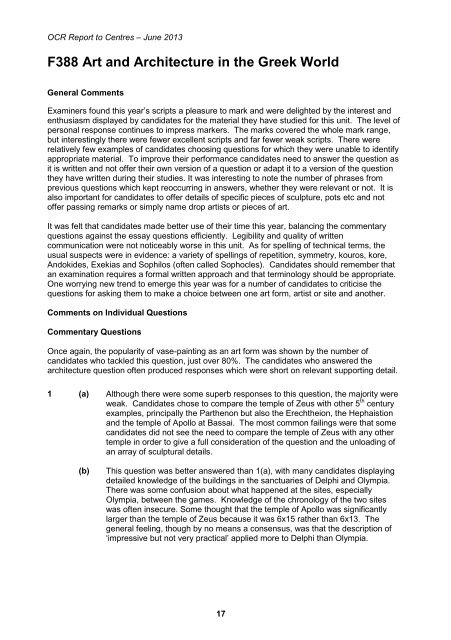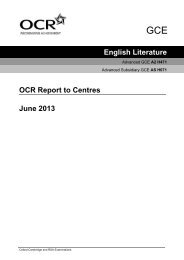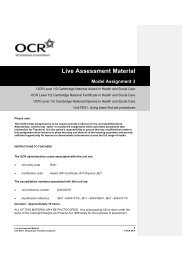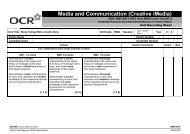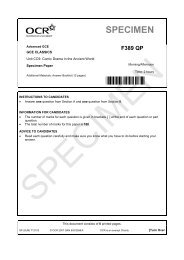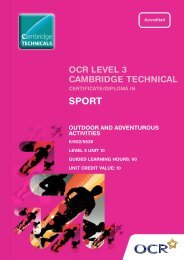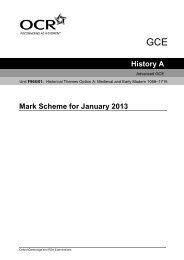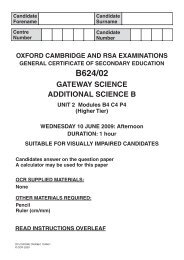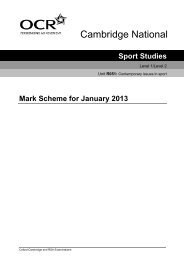Examiners' reports - June (PDF, 440KB) - OCR
Examiners' reports - June (PDF, 440KB) - OCR
Examiners' reports - June (PDF, 440KB) - OCR
You also want an ePaper? Increase the reach of your titles
YUMPU automatically turns print PDFs into web optimized ePapers that Google loves.
<strong>OCR</strong> Report to Centres – <strong>June</strong> 2013<br />
F388 Art and Architecture in the Greek World<br />
General Comments<br />
Examiners found this year’s scripts a pleasure to mark and were delighted by the interest and<br />
enthusiasm displayed by candidates for the material they have studied for this unit. The level of<br />
personal response continues to impress markers. The marks covered the whole mark range,<br />
but interestingly there were fewer excellent scripts and far fewer weak scripts. There were<br />
relatively few examples of candidates choosing questions for which they were unable to identify<br />
appropriate material. To improve their performance candidates need to answer the question as<br />
it is written and not offer their own version of a question or adapt it to a version of the question<br />
they have written during their studies. It was interesting to note the number of phrases from<br />
previous questions which kept reoccurring in answers, whether they were relevant or not. It is<br />
also important for candidates to offer details of specific pieces of sculpture, pots etc and not<br />
offer passing remarks or simply name drop artists or pieces of art.<br />
It was felt that candidates made better use of their time this year, balancing the commentary<br />
questions against the essay questions efficiently. Legibility and quality of written<br />
communication were not noticeably worse in this unit. As for spelling of technical terms, the<br />
usual suspects were in evidence: a variety of spellings of repetition, symmetry, kouros, kore,<br />
Andokides, Exekias and Sophilos (often called Sophocles). Candidates should remember that<br />
an examination requires a formal written approach and that terminology should be appropriate.<br />
One worrying new trend to emerge this year was for a number of candidates to criticise the<br />
questions for asking them to make a choice between one art form, artist or site and another.<br />
Comments on Individual Questions<br />
Commentary Questions<br />
Once again, the popularity of vase-painting as an art form was shown by the number of<br />
candidates who tackled this question, just over 80%. The candidates who answered the<br />
architecture question often produced responses which were short on relevant supporting detail.<br />
1 (a) Although there were some superb responses to this question, the majority were<br />
weak. Candidates chose to compare the temple of Zeus with other 5 th century<br />
examples, principally the Parthenon but also the Erechtheion, the Hephaistion<br />
and the temple of Apollo at Bassai. The most common failings were that some<br />
candidates did not see the need to compare the temple of Zeus with any other<br />
temple in order to give a full consideration of the question and the unloading of<br />
an array of sculptural details.<br />
(b)<br />
This question was better answered than 1(a), with many candidates displaying<br />
detailed knowledge of the buildings in the sanctuaries of Delphi and Olympia.<br />
There was some confusion about what happened at the sites, especially<br />
Olympia, between the games. Knowledge of the chronology of the two sites<br />
was often insecure. Some thought that the temple of Apollo was significantly<br />
larger than the temple of Zeus because it was 6x15 rather than 6x13. The<br />
general feeling, though by no means a consensus, was that the description of<br />
‘impressive but not very practical’ applied more to Delphi than Olympia.<br />
17


